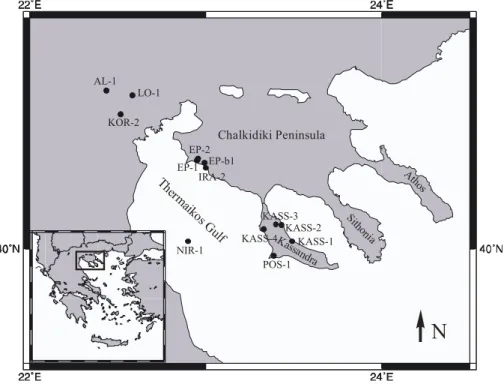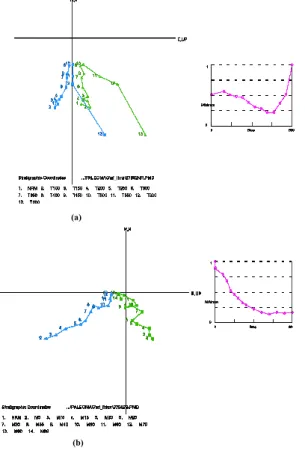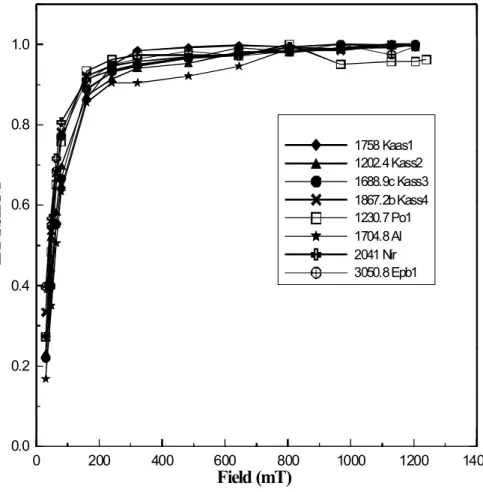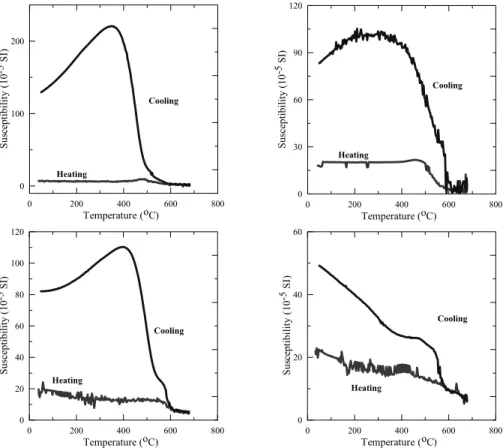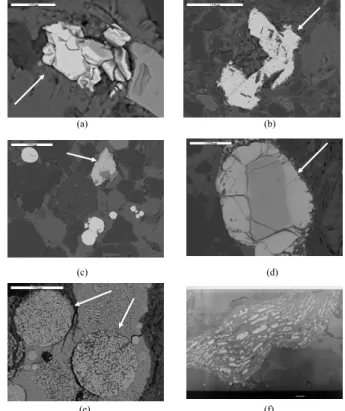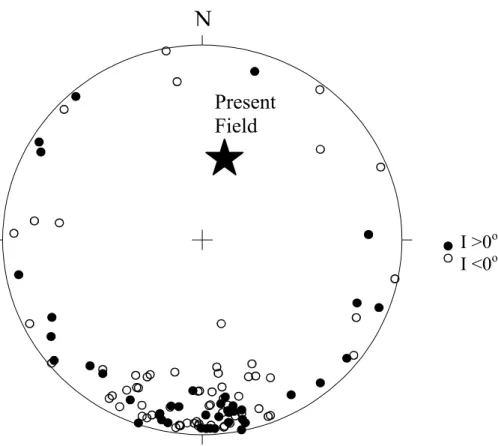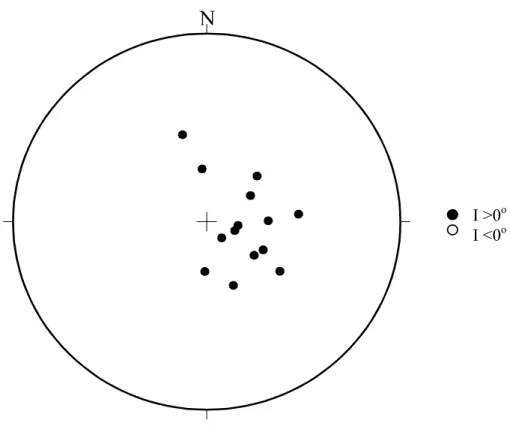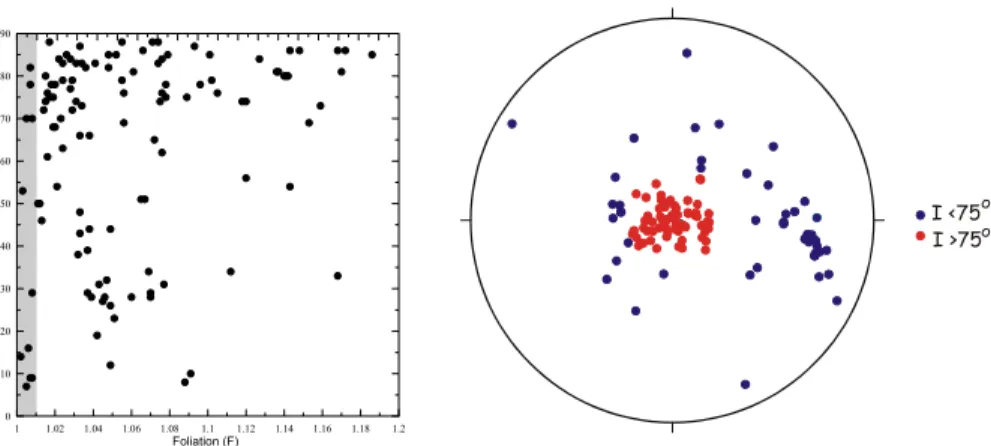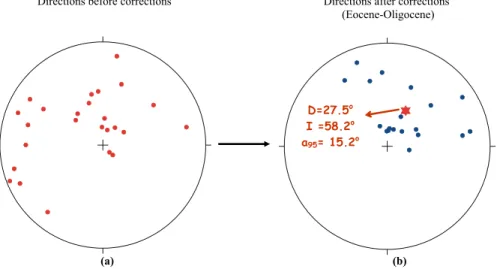HAL Id: hal-00298249
https://hal.archives-ouvertes.fr/hal-00298249
Submitted on 21 Mar 2007HAL is a multi-disciplinary open access
archive for the deposit and dissemination of sci-entific research documents, whether they are pub-lished or not. The documents may come from teaching and research institutions in France or abroad, or from public or private research centers.
L’archive ouverte pluridisciplinaire HAL, est destinée au dépôt et à la diffusion de documents scientifiques de niveau recherche, publiés ou non, émanant des établissements d’enseignement et de recherche français ou étrangers, des laboratoires publics ou privés.
Palaeomagnetic investigations of sediments cores from
Axios zone (N. Greece): implications of low inclinations
in the Aegean
E. Aidona, D. Kondopoulou, R. Scholger, A. Georgakopoulos, A. Vafeidis
To cite this version:
E. Aidona, D. Kondopoulou, R. Scholger, A. Georgakopoulos, A. Vafeidis. Palaeomagnetic investiga-tions of sediments cores from Axios zone (N. Greece): implicainvestiga-tions of low inclinainvestiga-tions in the Aegean. eEarth Discussions, 2007, 2 (1), pp.37-68. �hal-00298249�
eED
2, 37–68, 2007 Paleomagnetism in sediments cores E. Aidona et al. Title Page Abstract Introduction Conclusions References Tables Figures ◭ ◮ ◭ ◮ Back CloseFull Screen / Esc
Printer-friendly Version Interactive Discussion
EGU eEarth Discuss., 2, 37–68, 2007
www.electronic-earth-discuss.net/2/37/2007/ © Author(s) 2007. This work is licensed under a Creative Commons License.
eEarth Discussions
eEarth Discussions is the access reviewed discussion forum of eEarth
Palaeomagnetic investigations of
sediments cores from Axios zone (N.
Greece): implications of low inclinations
in the Aegean
E. Aidona1, D. Kondopoulou1, R. Scholger2, A. Georgakopoulos3, and A. Vafeidis4
1
Dept. of Geophysics, School of Geology Univ. of Thessaloniki, Greece
2
Paleomagnetic Laboratory Institute of Geophysics – University of Leoben, Austria
3
Dept. of Mineralogy-Petrology-Economic Geology, School of Geology, Univ. of Thessaloniki, Greece
4
Department of Mineral Resources Engineering, Technical, University of Crete, Chania, Greece
Received: 26 February 2007 – Accepted: 3 March 2007 – Published: 21 March 2007 Correspondence to: E. Aidona (aidona@geo.auth.gr)
eED
2, 37–68, 2007 Paleomagnetism in sediments cores E. Aidona et al. Title Page Abstract Introduction Conclusions References Tables Figures ◭ ◮ ◭ ◮ Back CloseFull Screen / Esc
Printer-friendly Version Interactive Discussion
EGU
Abstract
Sediment cores from 13 deep boreholes (1–4.1 km) from Axios zone in Northern Greece have been studied by means of palaeomagnetism. Both low field magnetic susceptibility and intensity of the natural remanent magnetization (NRM) indicate rather weakly magnetised materials. 390 samples have been subjected to
demagnetiza-5
tion process (AF and thermal) revealing in most of the cases the presence of mag-netite. Isothermal remanent magnetization (IRM) acquisition curves and thermomag-netic analysis suggest the dominance of magnetite. 30 thin sections were studied in order to more precisely characterise the magnetic mineralogy of the samples. This investigation also reveals the presence of magnetite and pyrite in framboidal form. An
10
attempt to re-orient some of the samples was partially successful by using the viscous component and the anisotropy method. Re-orientation techniques were applied in or-der to correct the palaeomagnetic directions due to the orientation ambiguity of the core samples. The palaeomagnetic results confirm the clockwise Cenozoic rotation, in the study area in agreement with the overall pattern of the onshore results from previous
15
investigations.
Finally, the observed inclinations of characteristic remanences in these rocks are much lower than the expected ones but converge with those obtained from formations on land.
1 Introduction
20
Numerous palaeomagnetic studies in Greece have contributed to the better under-standing of the geotectonic framework of the area and to the establishment of magne-tostratigraphic columns (Duermeijer et al., 2000; Kondopoulou 2000, and references therein; Van Hinsbergen et al., 2005). In particular, the presence of stable magne-tization components of different ages is indicated from previous palaeomagnetic and
25
eED
2, 37–68, 2007 Paleomagnetism in sediments cores E. Aidona et al. Title Page Abstract Introduction Conclusions References Tables Figures ◭ ◮ ◭ ◮ Back CloseFull Screen / Esc
Printer-friendly Version Interactive Discussion
EGU on and around the Chalkidiki peninsula in Northern Greece (Fig. 1) (Kondopoulou and
Westphal, 1986; Edel et al., 1991; Feinberg et al., 1994; Kondopoulou, 1994; Haubold et al., 1997). These components imply the presence of clockwise rotation for the Ceno-zoic, consistent with the general pattern of the broader area. On the other hand, incli-nation values are usually lower than expected by 5◦
–20◦
(Kondopoulou and Westphal,
5
1986; Kondopoulou et al., 1996; Beck et al., 2001). However, it should be noted that these low inclinations have been observed only at surface outcrops or borehole sam-ples from shallow coring of lake sediments (Papamarinopoulos, 1978). Preliminary results from early palaeomagnetic and rock magnetic investigations from four deep-drill cores (Kass1, Kass2, Kass3, Kass4) have already been published in a previous
10
paper (Aidona et al., 2001).
In the present study we present palaeomagnetic information from a large number of core samples from 13 deep boreholes (up to 4000 m) that were drilled down by the Greek Petroleum Company for oil exploration. It must be clarified that in these boreholes core sampling is sparse and is limited only on few specific strata of interest.
15
The vast drilling procedure produces only small fragments (“cuttings”). Nevertheless, the dataset which was obtained provides valuable information both on the validity of the rotational pattern and the long-standing problem of the low inclination values in the broader area.
2 Geological setting and sampling
20
The study area includes the north (Giannitsa-Thessaloniki plain) and eastern (West Chalkidiki and Kassandra peninsula) margins of Thermaikos gulf. From the geotec-tonic point of view the area belongs to the Axios zone (internal Hellinides). Mesozoic rocks (limestones, ophiolites) of Axios zone form the basement of the area. During Pa-leogene an extensive NNW-SSE trending trench was formed and filled by PaPa-leogene
25
molasic sediments (sandstones, few limestones), while in Miocene a new NNW-SSE graben was formed again and filled gradually during Neogene-Quaternary by mainly
eED
2, 37–68, 2007 Paleomagnetism in sediments cores E. Aidona et al. Title Page Abstract Introduction Conclusions References Tables Figures ◭ ◮ ◭ ◮ Back CloseFull Screen / Esc
Printer-friendly Version Interactive Discussion
EGU clastic sediments (sands, sandstones, clays, red beds) and few marls and limestones
(Antonios Fm, Triglia Fm, Trilofos Fm, Moudania Fm) (Syrides, 1990). At present, basement and Paleogene sediments expose at the mountainous periphery of the Ther-maikos gulf while in the low relief hilly area the basement is covered by the Neogene – Quaternary deposits exceeding 4000 m in thickness.
5
Axios area (drills Kor-2, Al-1, Lo-1) belongs to the Paiko zone. This zone consists of volcano-sedimentary rocks of Upper Jurassic age, a calcareous horizon of the same age and flysch of Low Cretaceous age which is covered by Middle-Upper Cretaceous sediments (Mercier, 1968).
In order to simplify descriptions the sampled cores are grouped into 4 sets according
10
to their position: Axios area (Kor-2, Al-1, Lo-1), Kassandra peninsula (Kass1-2-3-4, Po-1) Epanomi (Ep-1, Ep-2, Ep-b1, Ira-2) and a submarine core, Nireas-1 (Fig. 1).
The stratigraphy of the drilled cores is rather simple: all 4 groups contain a thick clastic sediment layer, which covers the pre-Neogene basement (Fig. 2). In particular, in the Kassandra set, the clastic layer (Eocene-Miocene) overlays the ophiolite
base-15
ment. In Epanomi set the clastic layer of Eocene-Pliocene age covers the Jurassic limestone and in Axios set the same clastic sediments (Eocene-Pliocene) overlay the Mesozoic metamorphic basement (Georgala, 1990, 1994).
From all these deep boreholes, 620 core samples from various depths were ob-tained. In the laboratory 390 of these samples were demagnetized using thermal and
20
alternating field demagnetization. Tilt values have been measured only for Kass3, and Kass4 boreholes and suggest limited tilting (<15◦) of the samples units, with only few
eED
2, 37–68, 2007 Paleomagnetism in sediments cores E. Aidona et al. Title Page Abstract Introduction Conclusions References Tables Figures ◭ ◮ ◭ ◮ Back CloseFull Screen / Esc
Printer-friendly Version Interactive Discussion
EGU
3 Laboratory treatment
3.1 Palaeomagnetic measurements
The magnetic susceptibility from all 620 specimens was measured with a Bartington MS2 device at low frequency (0.47 kHz). The mean susceptibilities as well as the mean intensities values for the 13 boreholes are displayed in Table 1. The mean susceptibility
5
for the samples of Epanomi group shows negative values, which indicate the presence of paramagnetic minerals into their structure. The majority of the other boreholes show a mean susceptibility, ranging from 12–18 X SI−5 units and only Kor-2 gives mean
susceptibility values up to 28 X SI−5units.
The natural remanent magnetization (NRM) of all 620 specimens was initially
mea-10
sured on a Molspin spinner magnetometer. The samples from Epanomi group turned to be very weakly magnetized (around 0.2 mA/m) thus they were measured on a cryo-genic magnetometer. All the remaining samples showed higher intensities of magneti-zation, up to 20 mA/m (Kor-2) (Table 1).
Magnetic cleaning was performed in 390 specimens by using thermal stepwise (Th)
15
with 50◦C step and alternating field (AF) with 5 mT–10 mT step, demagnetizations.
3.2 Rock magnetism and mineralogical analysis
Isothermal remanent magnetization (IRM) and thermomagnetic analysis have been performed on 70 specimens for the determination of the magnetic carriers. The IRM was imparted using a pulse magnetizer and was measured on a spinner
magnetome-20
ter. The majority of the thermomagnetic analyses were performed on a KLY-3 Kap-pabridge which measures the variation of the magnetic susceptibility with temperature. Only for few samples the Susceptibility Temperature Bartington Device was used.
30 polished thin sections were prepared and were studied by reflected light mi-croscopy under high magnification, in order to investigate the distribution of the
miner-25
eED
2, 37–68, 2007 Paleomagnetism in sediments cores E. Aidona et al. Title Page Abstract Introduction Conclusions References Tables Figures ◭ ◮ ◭ ◮ Back CloseFull Screen / Esc
Printer-friendly Version Interactive Discussion
EGU Scanning Electron Microscope, equipped with a LINK ISIS microanalyzer and using
carbon coated samples.
4 Results
The majority of the samples of Kassandra and Axios areas were weakly magnetized but stable components have been isolated in most cases. The thermal stepwise
de-5
magnetization has been successful up to 400◦–450◦C. Above this temperature, the
intensity of the magnetization consistently increased in the majority of the samples (Fig. 3a). This behavior is probably related to alteration (oxidation) of pyrite, which is present in all samples and to the formation of new parasitic minerals which overlap the high coercivity component of magnetization of the samples. Thus, the high
tempera-10
ture component has been lost and only a stable low temperature component (between 200◦–450◦C) has been isolated. In reverse, the AF demagnetization process proved
to be more successful for the determination of the magnetic components, as during the AF procedure generation of new parasitic minerals is avoided (Fig. 3b). There-fore, the characteristic component of magnetization was possible to isolate in most of
15
the samples in fields between 20–80 mT. The thermal and AF demagnetizations were performed in twin specimens, so the high coercivity component calculated by AF was used as a reference for checking the stable direction obtained through the thermal pro-cedure. The criteria used to decide whether or not a direction would be considered as reliable were: a) a smooth decay curve, b) no variation of susceptibility during heating,
20
c) alignment of at least 4 points, and e) a reliable a95 value (<15◦). The
characteris-tic directions of the magnetization were determined by least squares fitting (Principal Component Analysis) through selected points. All samples from Epanomi area were rejected due to their extremely low intensity of magnetization.
IRM measurements reveal the dominance of magnetite as the main magnetic carrier
25
in most of our samples (Fig. 4). Many samples achieve their saturation remanence in fields of 200–300 mT. In few cases the saturation is not reached up to 1200 mT, thus
eED
2, 37–68, 2007 Paleomagnetism in sediments cores E. Aidona et al. Title Page Abstract Introduction Conclusions References Tables Figures ◭ ◮ ◭ ◮ Back CloseFull Screen / Esc
Printer-friendly Version Interactive Discussion
EGU indicating the presence of hematite. Thermomagnetic analysis confirms the dominance
of magnetite, as the maximum blocking temperature reaches 580◦C in most of the
cases. It is also clear that during the heating, secondary magnetite is formed (Fig. 5). Finally, the study of the thin sections confirms the presence of magnetite, hematite and pyrite and reveals the presence of ilmenite and chromite (Fig. 6). Magnetite is
5
considered as a detrital mineral coming from the surrounding igneous and metamor-phic rocks deposited in the sedimentary basin. Pyrite microcrysts appear mainly in the framboidal form but clouds of pyrite microcrysts not organized in framboids are also present (Fig. 6). The framboids are usually found in colonies, filling, in some cases, fossils of micro-organisms (Fig. 6). The presence of framboidal pyrite is attributed to
10
low temperature and neutral to alkaline pH values. These conditions reduce pyrite sol-ubility and are essential for the formation and following preservation of the framboids (Rickard, 1969, 1970).
5 Re-orientation of cores
In order to derive palaeomagnetic results from cores it is necessary, as a first step, to
15
bring back core pieces into their initial position with respect to north and to vertical. For this reason, in the last decades, a number of new techniques of re-orientation of cores have been developed, and, among others, the palaeomagnetic reorientation. This method is based on the isolation of the viscous component of the magnetization which records the direction of the present geomagnetic field (Fuller, 1969; Van der
20
Voo and Watts, 1978; Shibuya et al., 1991; Hailwood and Ding, 1995). According to this method we isolate the viscous component from our samples but as it is shown in a stereographic projection in Fig. 7 the majority of the samples show very shallow inclination values. This fact leads us to the conclusion that it is impossible to use these values in order to re-orient our cores. It seems that a parasitic magnetization which was
25
created into the stockroom (Athens storage center) had affected the samples. Thus, storage in horizontal position of the samples for several years leads to the destruction
eED
2, 37–68, 2007 Paleomagnetism in sediments cores E. Aidona et al. Title Page Abstract Introduction Conclusions References Tables Figures ◭ ◮ ◭ ◮ Back CloseFull Screen / Esc
Printer-friendly Version Interactive Discussion
EGU of their viscous component of the magnetization. Samples from Axios cores seem
to be the exception (Fig. 8). As these samples were stored in another stockroom (Kavala storage center), they have obviously not been affected by the same parasitic magnetization.
Regarding the position of the cores with respect to the vertical, the method of
5
anisotropy of the magnetic susceptibility was applied (Hailwood and Ding, 1995). By measuring the anisotropy of magnetic susceptibility we could determine the plane of kmax and kint and the position of the kmin axe of anisotropy. For a sedimentary
se-quence which was deposited in an undisturbed environment, the kmin axe would be
perpendicular to the bedding plane (Hamilton and Rees, 1970; Tarling and Hrouda,
10
1993). Measurements of anisotropy of the magnetic susceptibility were performed in 120 specimens and the results are shown in Fig. 9. Only specimens with values of magnetic foliation higher than 1.010 were considered reliable and among these, sam-ples with kmin inclination values (blue circles) less than 75◦ were corrected. Thus, a
small set of samples (10% of the total) with corrected declination and inclination values
15
was derived (Fig. 10). A large dispersion is observed for both declination and inclina-tion values but within reasonable limits of reliability. Nevertheless, some general trends can be safely recognized and will be discussed in the next paragraph.
6 Discussion
In spite of the generally weak magnetizations the careful palaeomagnetic and rock
20
magnetic studies of the cores were successful in isolating stable components in most cases. The obtained magnetic parameters can be exploited mostly as far as the in-clination values are concerned. In Table 2 all the obtained results from this study are presented. The criteria used for the acceptance or rejection of the samples, are based on inclination values, a95 values and the number of specimens measured from every
25
core sample. It is important to notice that the final grouping of the results was based on their age distribution.
eED
2, 37–68, 2007 Paleomagnetism in sediments cores E. Aidona et al. Title Page Abstract Introduction Conclusions References Tables Figures ◭ ◮ ◭ ◮ Back CloseFull Screen / Esc
Printer-friendly Version Interactive Discussion
EGU A mean inclination was computed using the method of Enkin and Watson (1996),
which disregards all declination data. Inclination values have been compiled for the Eocene-Oligocene and separately for the basement. Results are as follows:
I=32.9+5.6
−5.6, κ=10, for the Oligocene, I=44.3 +5.2
−4.7, κ=9 for the Eocene and I=31.1 +7.9 −6.9,
κ=10 for the ophiolite basement (Jurassic?). 5
Inclination data from an allochthonous ophiolite cannot be interpreted unless the palaeohorizontal can be determined. This is practically impossible for drill core materi-als. In order to overcome this difficulty and properly evaluate the observed inclination values, we have compiled all published data from onshore formations from the broader area (Table 3a). The general agreement of inclination values from the two datasets is
10
supported by one particular case. Palaeomagnetic results from ophiolites and associ-ated sediments in the edge of Kassandra peninsula yield a direction with D=325.4◦and
I=34.1◦for the Mesozoic component (Feinberg et al., 1996). Given that in this case the
palaeohorizontal was unambiguously determined, it is clear that this inclination value (34.1◦
) can be used as a reference value for inclination data from the neighboring area.
15
In Fig. 11 the distribution of inclination values for Kassandra area is shown. It is observed that Eocene inclination values for drill cores Kass4 and Pos are much higher than for the other boreholes. This difference indicates the presence of local intense tectonic events (fast block tiltings) during the end of Eocene. This fact is in good agree-ment with the formation of the sediagree-mentary basin and its rapid extension after Middle
20
Eocene as confirmed by the sedimentological study (Roussos, 1994). If we extend the broader area to a largest one, up to the western edge of the Pelagonian zone a small dataset with published directions (Table 3b) displays a range of inclinations com-parable with the low inclinations calculated in the present study but divergent from the observed high inclinations in the two drill cores Kass4 and Pos. Also, the eastern part
25
of the study area (Sithonia and central Chalkidiki) gives similar low inclination results for Eo-Oligocene plutonic formations (I=31◦
). Therefore, it can be derived that the overall inclination is low and the high inclinations in Kass4 and Pos are strictly limited to the internal part of the Thermaikos gulf possibly due to local tectonism related to the
eED
2, 37–68, 2007 Paleomagnetism in sediments cores E. Aidona et al. Title Page Abstract Introduction Conclusions References Tables Figures ◭ ◮ ◭ ◮ Back CloseFull Screen / Esc
Printer-friendly Version Interactive Discussion
EGU formation of the graben of Thermaikos gulf.
The expected inclination values computed from the European apparent polar wan-der path are 51◦ (Westphal et al., 1986) or 53.7◦ (Besse and Courtillot, 2002) for the
Eocene and 56◦ (Westphal et al., 1986) or 54◦ (Besse and Courtillot, 2002) for the
Oligocene. Taking these values into account the observed inclination values are
consis-5
tently low (31◦/44◦) for Eocene-Oligocene formations or Eocene overprints (Table 3a).
The comparison of the two datasets clearly shows that inclination values from both on-shore and borehole formations are compatible and much lower than the expected val-ues (by ∼20◦). A second dataset, comprising results from reoriented samples (Fig. 10)
should be examined with due care. In this small group (N=25) the mean declination
10
value is in a good agreement with almost all published on-shore results for the broader Chalkidiki area (Table 3a). As far as the inclination values are concerned their mean (I=58.2◦) is close to the expected ones for the area and the Eocene-Oligocene period.
At a first approach this could be in contradiction with the generally lower inclination values measured in the present dataset but also in the published in-shore data. This
15
divergence is not representative since the data used for the reorientation are derived from the cores Kass4, Pos and Kor-1 where high inclination values prevail. Therefore, the mean inclination value for reoriented samples is shifted to a higher range. For all these reasons, we consider as representative the inclinations obtained from the totality of the studied samples.
20
The problem of low inclinations for the Cenozoic formations in the broader Aegean area has been widely discussed (Kissel and Laj, 1988; Van der Voo, 1993; Beck and Schermer, 1994; Beck et al., 2001; Kissel et al., 2003). The thorough examination of this problem by Beck et al. (2001) led to the suggestion of a NW motion of the Aegean block by ∼500 Km with respect to N. Europe, which cannot be supported by
25
geological data. In their discussion on shallow inclinations in the Aegean realm, Kissel et al. (2003) conclude that the problem is not fully understood. A different approach used by Krijgsman and Tauxe, (2004) based on the “elongation/inclination” method of Tauxe and Kent (2004), led the authors to the suggestion that an inclination error is
eED
2, 37–68, 2007 Paleomagnetism in sediments cores E. Aidona et al. Title Page Abstract Introduction Conclusions References Tables Figures ◭ ◮ ◭ ◮ Back CloseFull Screen / Esc
Printer-friendly Version Interactive Discussion
EGU the main responsible for low inclinations in sedimentary formations and inappropriate
tilt corrections for the ones observed in lava flows in the area. This last assumption is based on the Beck et al. (2001) study of volcanic rocks in Lesvos island. As far as the sediments are concerned their conclusion seems realistic and converges with the one of Kissel et al. (2003). On the other hand, we believe that “inappropriate tilt”
5
is a very simplistic approach for lavas, as similar low inclinations in volcanics, have been reported from other Oligo-Miocene formations in the broader Aegean (Kissel et al., 1986a, b; Morris, 1995, 2000; Haubold et al., 1997). It is difficult to consider that in such a broad dataset obtained by different groups and with various sampling techniques, a systematic error in applying tilt corrections has occurred.
10
Several studies have revealed the same anomalous inclinations further to the region of central Asia (Hankard et al., 2007, and references therein). Chauvin et al. (1996) proposed that inclination anomaly progressively increases from 0◦on the Atlantic
mar-gin to about 10◦ in the eastern Mediterranean and Middle East to reach maximum of
25◦
in central Asia, due to a regional non-dipole field. Van der Voo and Torsvik (2001)
15
suggested that an octupole field may have been responsible for the palaeolatitude anomalies in central Asia, adopting the earlier suggestion by Westphal (1993). Finally Si and Van der Voo (2001) proposed that the large discrepancies between observed and predicted palaeolatitudes in Asia during latest Cretaceous and Tertiary can be ex-plained by the contribution of a long-term non-dipole field to the total time-averaged
20
geomagnetic field.
In the present study, as the on-shore data come mostly from plutonic rocks and are in good agreement with data from the borehole samples (both have shallow inclina-tions), we consider that inclination flattening does not contribute significantly to the observed inclination anomalies. Additionally, if the Eocene alternative pole for Eurasia
25
suggested by Westphal (1993) is taken into account (Iexp∼35◦) a satisfactory match is observed with the inclination values reported here, suggesting that large-scale crustal displacements are unnecessary for this geological period.
eED
2, 37–68, 2007 Paleomagnetism in sediments cores E. Aidona et al. Title Page Abstract Introduction Conclusions References Tables Figures ◭ ◮ ◭ ◮ Back CloseFull Screen / Esc
Printer-friendly Version Interactive Discussion
EGU
7 Conclusions
The study of drill sediments cores from Axios zone provided a set of meaningful results for an area and a time span in which such data are very scarce (Eocene – Oligocene). In the case of Epanomi samples, possible dolomitization could have affected these sediments, leading to their remagnetization. As a result the total magnetic grains were
5
replaced by paramagnetic ones destroying the remanent magnetization of the samples. The usage of the viscous component of the magnetization for the correction of dec-lination proved to be useless due to storage effect. Only in few cases the method was applied successfully and reorientation of declination (for these specific samples) was possible. The reorientation procedure might have proved more successful if data from
10
the totality of the boreholes could be used.
The calculated mean inclination values seem to be in good agreement with the over-all pattern of inclinations of the broader area from the on-shore formations. The total set of inclination values is lower than the expected ones following the magnetic pole of Eurasia.
15
The observed low inclinations in plutonic rocks and sediments in previously stud-ied on-shore formations, in combination with the results from the present study lead us to conclude that it is difficult to accept the sediment compaction as the dominant mechanism for low inclination. For the particular time range (Eocene-Oligocene) the alternative pole of Westphal (1993) could possibly give a satisfactory interpretation.
20
Nevertheless, the overall problem of shallow inclinations in the broader area remains still an open issue. Additional data from well-dated volcanic rocks of similar ages with severe control on stratigraphic corrections would be welcomed in order to elucidate the problem.
Acknowledgements. This study has been financed by a joint project between the Greek
25
Petroleum Company and the General Secretariat of Research and Technology. Part of the measurements has been performed in the palaeomagnetic Laboratory of the E.N.S. (Paris) through a bilateral project (PLATON) between France and Greece. Additional results have been obtained in Palaeomagnetic laboratory of Leoben, Austria. N. Roussos and D. Georgala
eED
2, 37–68, 2007 Paleomagnetism in sediments cores E. Aidona et al. Title Page Abstract Introduction Conclusions References Tables Figures ◭ ◮ ◭ ◮ Back CloseFull Screen / Esc
Printer-friendly Version Interactive Discussion
EGU
are warmly acknowledged for their help in obtaining samples and valuable information. All palaeomagnetic data were analyzed using PC programs developed by R. Enkin.
References
Aidona, E., Kondopoulou, D., Koufos, G., and Sen, S.: Magnetostratigraphy of late Miocene continental deposits in the Lower Axios Valley (Greece), 1st Congress of the Balkan Geo-5
physical Society, Athens, 1996.
Aidona E., Kondopoulou, D., and Georgakopoulos, A.: Palaeomagnetic and rock magnetic properties of sediments cores from Chalkidiki, Greece, Phys. Chem. Earth, 26(11–12), 879– 884, 2001.
Beck Jr., M. and Schermer, E.: Aegean palaeomagnetic inclination anomalies: Is there a tec-10
tonic explanation?, Tectonophysics, 231, 281–292, 1994.
Beck, M. E., Burmester, R. F., Kondopoulou, D. P., and Atzemoglou, A.: The palaeomagnetism of Lesvos, NE Aegean, and the eastern Mediterranean inclination anomaly, Geophys. J. Int., 145, 233–245, 2001.
Besse, J. and Courtillot, V.: Apparent and true polar wander and the geometry of
15
the geomagnetic field over the last 200 Myr, J. Geophys. Res., 107(B11), 2300, doi:10.1029/2000JB000050, 2002.
Chauvin, A., Perroud, H., and Bazhenov, M. L.: Anomalous low palaeomagnetic inclinations from Oligocene-Lower Miocene red beds of the southwest Tien Shan, Central Asia, Geophys. J. Int., 126, 303–313, 1996.
20
Duermeijer, C. E., Nyst, M., Meijer, P. Th., Langereis, C. G., and Spakman, W.: Neogene evolution of the Aegean arc: palaeomagnetic and geodetic evidence for a rapid and young rotation phase, Earth Planet. Sci. Lett., 176, 509–525, 2000.
Edel, J. B., Kondopoulou, D., Pavlides, S., and Westphal, M.: Multiphase paleomagnetic evo-lution of the Chalkidiki ophiolitic belt, Greece, Geotectonic implications, Bull. Geol. Soc. 25
Greece, 25, 370–392, 1991.
Enkin, R. J. and Watson, G. S.: Statistical analysis of palaeomagnetic inclination data, Geo-phys. J. Int., 126, 495–504, 1996.
eED
2, 37–68, 2007 Paleomagnetism in sediments cores E. Aidona et al. Title Page Abstract Introduction Conclusions References Tables Figures ◭ ◮ ◭ ◮ Back CloseFull Screen / Esc
Printer-friendly Version Interactive Discussion
EGU
northern Greece ophiolites and associated sediments, Bull. Geol. Soc. Greece, 30, 359– 370, 1994.
Feinberg, H., Edel, B., Kondopoulou, D., and Michard, A.: Implications of ophiolite palaeomag-netism for the interpretation of the geodynamics of Northern Greece, in: Palaeomagpalaeomag-netism and Tectonics of the Mediterranean region, edited by: Morris, A. and Tarling, D. H., Geologi-5
cal Society of London Special Publication, 105, 289–298, 1996.
Fuller, M.: Magnetic orientation of borehole core, Geophysics, 34, 772–774, 1969.
Georgala, D.: Sedimentological study of the borehole Kass4, Public Petroleum Company, In-ternal Report, 1990.
Georgala, D.: Sedimentological study of the boreholes Kass1, Kass2, Kass3, Public Petroleum 10
Company, Internal Report, 1994..
Hailwood, E. A. and Ding, F.: Palaeomagnetic reorientation of cores and the magnetic fabric of hydrocarbon reservoir sands, in: Palaeomagnetic Applications in Hydrocarbon Exporation, edited by: Turner, P. and Turner, A., Geological Society, London, Special Publications, 98, 245–258, 1995.
15
Hall, S. A. and Evans, I.: Palaeomagnetic and rock magnetic properties of hydrocarbon reser-voir rock from the Permian Basin, southeastern New Mexico USA, in: Palaeomagnetic Appli-cations in Hydrocarbon Exporation, edited by: Turner, P. and Turner, A., Geological Society, London, Special Publications, 98, 79–95, 1995.
Hamilton, N. and Rees, A. I.: The use of magnetic fabric in paleocurrent estimation, in: Palaeo-20
geophysics, edited by: Runcorn, S. K., Academic Press, London, 445–464, 1970.
Hankard, F., Cogne, J.-P., Kravchinsky, V. A., Carporzen, L., Bayasgalam, A., and Lkhagvadorj, P.: New Tertiary Palaeomagnetic poles from Mongolia and Siberia at 40,30,20 and 13 Ma: clues on the inclination shallowing problem in central Asia, J. Geophys. Res, 112, B02101, doi:10.1029/2006JB004488, 2007.
25
Haubold, H., Scholger, R., Kondopoulou, D., and Mauritsch, H. J.: New palaeomagnetic results from the Aegean extensional province, Geologie en Mijnbouw, 76, 45–55, 1997.
Haubold, H., Kondopoulou, D., Scholger, R., and Mauritsch, H. J.: Further palaeomagnetic evidence for the structural unroofing of the Rhodope metamorphic core complex, Abstract in EGS99, 1999.
30
Kissel, C., Kondopoulou, D., Laj, C., and Papadopoulos, P.: New paleomagnetic data from Oligocene formations of Northern Aegean, Geophys. Res. Lett., 13(10), 1039–1042, 1986a. Kissel, C., Laj, C., and Mazaud, A.: Paleomagnetic results from Neogene formations in Evia,
eED
2, 37–68, 2007 Paleomagnetism in sediments cores E. Aidona et al. Title Page Abstract Introduction Conclusions References Tables Figures ◭ ◮ ◭ ◮ Back CloseFull Screen / Esc
Printer-friendly Version Interactive Discussion
EGU
Skyros and the Volos region and the deformation of Central Aegean, Geophys. Res. Lett., 13, 1446–1449, 1986b.
Kissel, C. and Laj, C.: The tertiary geodynamic evolution of the Aegean arc: a palaeomagnetic reconstruction, Tectonophysics, 146, 183–201, 1988.
Kissel, C., Laj, C., Poisson, A., and Gorur, N.: Paleomagnetic reconstruction of the Cenozoic 5
evolution of the Eastern Mediterranean, Tectonophysics, 362, 199–217, 2003.
Kondopoulou, D. and Westphal, M.: Paleomagnetism of the Tertiary intrusives from Chalkidiki, N. Greece, J. Geophys., 59, 62–66, 1986.
Kondopoulou, D.: Some constraints on the origin and timing of magnetization for Mio-Pliocene sediments from N. Greece, Bull. Geol. Soc. Greece, XXX/5, 53–66, 1994.
10
Kondopoulou, D., Atzemoglou, A., and Pavlides, S.: Palaeomagnetism as a tool for testing geo-dynamic models in the North Aegean: convergences, controversies and a further hypothesis, in: Palaeomagnetism and Tectonics of the Mediterranean Region, edited by: Morris, A. and Tarling, D. H., Geol. Soc. London Spec. Publ., 105, 277–288, 1996.
Kondopoulou, D.: Palaeomagnetism in Greece: Cenozoic and Mesozoic components and their 15
geodynamic implications, Tectonophysics, 326, 131–151, 2000.
Krijgsman, W. and Tauxe, L.: Shallow bias in Mediterranean paleomagnetic directions caused by inclination error, Earth Planet. Sci. Lett., 222, 685–695, 2004.
Mercier, J.: Etude geologique des zones Internes des Hellenides en Macedoine centrale (Crece), Contribution a l’etude du metamorphisme et de l’evolution magmatique des zones 20
internes des Hellenides, These, Paris 1966, Ann. Geol. Pays Hellen., 20, 1–792, 1968. Morris, A.: Rotational deformation during Palaeogene thrusting and basin closure in eastern
central Greece: palaeomagnetic evidence from Mesozoic carbonates, Geophys. J. Int., 121, 827–847, 1995.
Morris, A.: Magnetic fabric and paleomagnetic analyses of the Plio-Quaternary calc-alkaline 25
series of Aegina Island, South Aegean volcanic arc, Greece, Earth Planet. Sci. Lett., 176, 91–105, 2000.
Papamarinopoulos, S.: Limnomagnetic studies on Greek sediments, PhD Thesis, Univ. of Ed-inburgh, 94 p, 1978.
Rickard, D. T.: The chemistry of iron sulfide formation at low temperature. Stockholm Contr, 30
Geology, 20, 67–95, 1969.
Rickard, D. T.: The origin of framboids, Lithos, 3, 269–293, 1970.
eED
2, 37–68, 2007 Paleomagnetism in sediments cores E. Aidona et al. Title Page Abstract Introduction Conclusions References Tables Figures ◭ ◮ ◭ ◮ Back CloseFull Screen / Esc
Printer-friendly Version Interactive Discussion
EGU
the North Aegean area, Bull. Geol. Soc. Greece, XXX/2, 275–294, 1994.
Sen, S., Koufos, G., Kondopoulou, D., and de Bonis, L.: Magnetostratigraphy of Late Miocene continental deposits of the Lower Axios valley, Macedonia, Greece, Geol. Soc. Greece, Spe-cial Publ., 9, 197–206, 2000.
Si, J. and Van der Voo, R.: Too-low magnetic inclinations in central Asia: an indication of a 5
long-term Tertiary non-dipole field? Terra Nova, 13, 471–478, 2001.
Shi, H.: Some magnetic properties of bore core sediments, PhD thesis, University of Plymouth, 1996.
Shibuya, H., Merrill, D. L., Hsu, V., and Leg 124 Shipboard Scientific party: Paleogene coun-terclockwise rotation of the Celebes Sea- orientation of ODP cores utilizing the secondary 10
magnetization, in: Proceedings of the Ocean Drilling Program, edited by: Silver, E. A., Ran-gin, C., and von Breyman, M. T., Seintific Results, 124, 1991.
Syrides, E. G.: Lithostratigraphic, biostratigraphic and palaeogeographic study of the Noegene-Quaternary sedimentary deposits of Chalkidiki peninsula, Macedonia, Greece, PhD Thesis, University of Thessaloniki, 243 p, 1990.
15
Tarling, D. H. and Hrouda, F.: The Magnetic Anisotropy of Rocks, Chapman and Hall, 217 p, 1993.
Tauxe, L. and Kent, D. V.: A new statistical model for the geomagnetic field and the detection of shallow bias in paleomagnetic inclinations: was the ancient magnetic field dipolar?, in: Timescales of the Internal Geomagnetic Field, edited by: Channell, J. E. T., Kent, D. V., 20
Lowrie, W., Meert, J., Geophysical Monograph, 145, 101–116, 2004.
Van Hinsbergen, D. J. J., Langereis, C. G., and Meulenkamp, J. E.: Revision of the timing, mag-nitude and distribution of Neogene rotations in the western Aegean region, Tectonophysics, 396, 1–34, 2005.
Van der Voo, R. and Watts, D. R.: Palaeomagnetic results from igneous and sedimentary rocks 25
from Michigan Basin borehole, J. Geophys. Res., 83, 5844–5848, 1978.
Van der Voo, R.: Palaeomagnetism of the Atlantic, Tethys and Iapetus Oceans, Cambridge Univ. Press, 421 p, 1993.
Van der Voo, R. and Torsvik, T. H.: Evidence for Late Paleozoic and Mesozoic non-dipole fields provides an explanation for the Pangea reconstruction problems, Earth Planet. Sci. Lett., 30
187, 71–81, 2001.
Westphal, M., Bazhenov, M., Lauer, J. P., Pechersky, M., and Sibuet, J. C.: Palaeomagnetic implications on the evolution of the Tethys belt from the Atlantic ocean to the Pamir since the
eED
2, 37–68, 2007 Paleomagnetism in sediments cores E. Aidona et al. Title Page Abstract Introduction Conclusions References Tables Figures ◭ ◮ ◭ ◮ Back CloseFull Screen / Esc
Printer-friendly Version Interactive Discussion
EGU
Triassic, Tectonophysics, 123, 37–82, 1986.
Westphal, M., Kondopoulou, D., Edel, J. B., and Pavlides, S.: Palaeomagnetism of late Tertiary and Plio-Pleistocene formations from N. Greece, Bull. Geol. Soc. Greece, 25, 239–250, 1991.
Westphal, M.: Did a large departure from the geocentric axial dipole hypothesis occur during 5
the Eocene? Evidence from the magnetic Polar wander path of Eurasia, Earth Planet. Sci. Lett., 117(1/2), 15–29, 1993.
eED
2, 37–68, 2007 Paleomagnetism in sediments cores E. Aidona et al. Title Page Abstract Introduction Conclusions References Tables Figures ◭ ◮ ◭ ◮ Back CloseFull Screen / Esc
Printer-friendly Version Interactive Discussion
EGU
Table 1. Mean values of intensity and magnetic susceptibility for all studied cores.
Name N Mean Intensity Value (mA/m) Mean Susceptibility Value (SI 10−5)
EP-1 (Cores1-2) 10 1.138 18.17 EP-1 (Cores 3–7) 24 0.137 −0.366 EP-2 21 0.081 1.127 EP-B1 36 0.196 −0.113 IRA-2 65 0.012 −0.377 KASS-1 56 2.43 16.1 KASS-2 66 0.88 11.93 KASS-3 59 1.34 14.02 KASS-4 91 1.51 16.26 PO-1 119 5.32 17.92 Kor-2 26 26.43 28.08 Al-1 14 8.41 15.84 Lo-1 8 0.34 2.97 Nir-1 26 2.68 14.43
eED
2, 37–68, 2007 Paleomagnetism in sediments cores E. Aidona et al. Title Page Abstract Introduction Conclusions References Tables Figures ◭ ◮ ◭ ◮ Back CloseFull Screen / Esc
Printer-friendly Version Interactive Discussion
EGU
Table 2. Obtained results from the present study. Name = name of the borehole, I =
incli-nation value, a95=95% cone of confidence, k = Fisher’s precision parameter, n = number of
specimens, A = accepted, R = rejected (see in the text for details).
Name I a95 k n Comment Kass-1 1117–1120 10.8 4.3 73.39 12 A 1160 23.1 40.9 165.3 3 R 1190 3.6 42.3 155.4 3 R 1443 27.3 40.4 8.87 3 A 1544–1547 31.8 11.5 21.8 7 A 1758 24.6 12.6 52.75 4 A Kass-2 1133–1140 30.8 10.9 10.83 13 A 1198–2005 23.8 9.7 16.58 11 A 1464 39.3 – 5.53 3 R Kass-3 1688–1694 33.7 9.2 11.68 16 A 1867–1869 38.5 39.8 3.83 5 A 1971–1974 35.3 17.3 8.3 8 A Kass-4 1863–1869 21.8 11.1 12.69 11 A 2328–2335 23.6 16.5 7.71 9 A 2650–2655 77.1 4.0 1348 5 A 2796–2804 46.4 12.8 18.07 7 A 2902–2908 71.9 9.4 59.47 5 A 3040–3043 20.0 14 18.99 6 A Pos-1 1225–1231 28.1 11.4 10.94 12 A 2642–2648 24.8 12.1 8.17 14 A 3027–3032 26.9 23.9 5.5 7 A 3287–3290 64.0 13.5 21.57 6 A 3467–3472 62.5 8.0 29.5 10 A 4116–4118 38.3 19 14.66 5 A Kor-2 2704–2705 74.5 24.9 34.16 4 A 2742–2787 73.3 8.1 82.07 5 A 2796–2798 48 12.9 10.19 11 A Nir-1 2041–2047 30.2 25.7 13.19 4 A 2785–2787 19 12.6 53.34 4 A 3563–3567 65 5.3 48.33 13 A Al-1 1623–1626 27.1 18.3 11.37 6 A 1700–1704 53.2 19.6 7.27 8 A Lo-1 3011–3015 48.4 46.8 3.37 5 A
eED
2, 37–68, 2007 Paleomagnetism in sediments cores E. Aidona et al. Title Page Abstract Introduction Conclusions References Tables Figures ◭ ◮ ◭ ◮ Back CloseFull Screen / Esc
Printer-friendly Version Interactive Discussion
EGU
Table 3. (a) Published data for the broader area.
Area Formation Age N D I A95 Reference
1. Chalkidiki (Kassandra)
Sediments Mio-Pliocene 9 24.7 54.2 5 Haubold et al. (1999)
2. Axios Sediments Miocene 4 20 46 17 Aidona et al. (1996); Sen et al. (2000)
3. Strimonikos Plutonics Oligocene-Miocene 2 026 47 – Westphal et al. (1991)
4. Chalkidiki (Paliouri)
Sediments Eocene – Oligocene 4 220.2 −47.3 – Feinberg et al. (1994)
5. Chalkidiki (Sithonia-Ouranoupoli)
Plutonics Eocene – Oligocene 8 037 31 9 Kondopoulou and Westphal (1986) 6. Axios
(Oreokastro)
Plutonics Eocene 1 29.5 39 – Feinberg et al. (1994)
7. Axios (Goumennisa)
Plutonics Eocene 1 89 49 14 Feinberg et al. (1994)
8. Chalkidiki (Paliouri)
Sediments Jurassic 9 32.1 50 18 Feinberg et al. (1994)
9. Chalkidiki Ophiolites Jurassic 5 314 34 13 Edel et al. (1991) 10. Axios –
Chalkidiki
Ophiolites Jurassic (?) 16 318.7 36.5 9.5 Feinberg et al. (1996)
11. Chalkidiki (Monopigado)
Granites Jurassic 1 56.5 25 16 Feinberg et al. (1996)
Expected declination and inclination values for the area
Kassandra Eocene 10.4 50.8 Westphal et al. (1986)
Kassandra Eocene 10.1 53.9 Besse and Cour-tillot (2002) Kassandra Oligocene 8.2 56.4 Westphal et al.
(1986)
Kassandra Oligocene 10.3 56.1 Besse and Cour-tillot (2002)
eED
2, 37–68, 2007 Paleomagnetism in sediments cores E. Aidona et al. Title Page Abstract Introduction Conclusions References Tables Figures ◭ ◮ ◭ ◮ Back CloseFull Screen / Esc
Printer-friendly Version Interactive Discussion
EGU
Table 3. (b) Published data from the Mesohellenic basin.
Area Age N D I k A95 Reference
Mesohellenic Basin EE (mean) Oligocene-M.Miocene 6 51.7 28.2 19.5 15.5 Van Hinsbergen et al. (2005) Mesohellenic Basin EE (mean) Eocene – Oligocene 4 65.4 39.1 15.3 24.3 Van Hinsbergen et al. (2005) Mesohellenic Basin DD (mean) Oligocene – M.Miocene 8 51.0 20.3 25.8 11.1 Van Hinsbergen et al. (2005) Mesohellenic Basin Krania (mean) L. Eocene 6 46.4 19.5 27.2 13.1 Van Hinsbergen et al. (2005) Mesohellenic Basin SM (mean) 36–24 Ma 5 27.0 47.0 16.0 10.0 Kissel and Laj (1988)
eED
2, 37–68, 2007 Paleomagnetism in sediments cores E. Aidona et al. Title Page Abstract Introduction Conclusions References Tables Figures ◭ ◮ ◭ ◮ Back CloseFull Screen / Esc
Printer-friendly Version Interactive Discussion EGU AL-1 KOR-2 LO-1 EP-2 EP-b1 IRA-2 EP-1 KASS-4 KASS-3 KASS-2 KASS-1 POS-1 NIR-1 Th erm aikos G ulf Chalkidiki Peninsula Kassand ra Sitho nia A thos
N
Fig. 1. Schematic map of Chalkidiki Peninsula, where the location of the studied drill cores is
eED
2, 37–68, 2007 Paleomagnetism in sediments cores E. Aidona et al. Title Page Abstract Introduction Conclusions References Tables Figures ◭ ◮ ◭ ◮ Back CloseFull Screen / Esc
Printer-friendly Version Interactive Discussion EGU ~ ~ ~ ~ ~ ~~~ ~~ ~ ~ ~ ~~~ ~~~~ ~~ ~ ~ ~ ~ ~ ~~~ ~~ ~ ~~ ~~ ~~ ~~ ~~ ~ ~ ~ ~ ~ ~ ~~ ~ ~ ~ ~ ~ ~ ~ ~ ~ ~ ~~
~ ~~ Clastic sedimentsMetamorphic basement
0m -1000m -2000m -3000m -3000m -2000m -1000m 0m
KOR-2 AL-1 LO-1
0m -1000m -2000m -3000m -3000m -2000m -1000m 0m Clastic
sediments Limestones Granites
IRA-2 EP-b1
EP-1 EP-2
KASS1 KASS2 KASS3 KASS4 POS1
Clastic sediments Ophiolithic basement 0m -1000m -2000m -3000m -4000m 0m -1000m -2000m -3000m -4000m
KASS1 KASS2 KASS3 KASS4 POS1
Clastic sediments Ophiolithic basement 0m -1000m -2000m -3000m -4000m 0m -1000m -2000m -3000m -4000m
eED
2, 37–68, 2007 Paleomagnetism in sediments cores E. Aidona et al. Title Page Abstract Introduction Conclusions References Tables Figures ◭ ◮ ◭ ◮ Back CloseFull Screen / Esc
Printer-friendly Version Interactive Discussion
EGU
(a)
(b)
Fig. 3. Zijderveld diagrams and normalized magnetic intensity curves with stepwise AF thermal (a) and AF (b) demagnetization for representative samples. Open squares: projection onto the
vertical plan, Black squares: projection onto the horizontal plan T100: Thermal demagnetiza-tion at 100◦C, M10: AF demagnetization at 10 mT.
eED
2, 37–68, 2007 Paleomagnetism in sediments cores E. Aidona et al. Title Page Abstract Introduction Conclusions References Tables Figures ◭ ◮ ◭ ◮ Back CloseFull Screen / Esc
Printer-friendly Version Interactive Discussion EGU 0 200 400 600 800 1000 1200 1400
Field (mT)
0.0 0.2 0.4 0.6 0.8 1.0IR
M
/S
IR
M
1758 Kaas1 1202.4Kass2 1688.9c Kass3 1867.2bKass4 1230.7Po1 1704.8Al 2041 Nir 3050.8Epb1eED
2, 37–68, 2007 Paleomagnetism in sediments cores E. Aidona et al. Title Page Abstract Introduction Conclusions References Tables Figures ◭ ◮ ◭ ◮ Back CloseFull Screen / Esc
Printer-friendly Version Interactive Discussion EGU 0 200 400 600 800 Temperature (oC) 0 20 40 60 S u sc ep ti b il it y ( 1 0 -5 S I) 0 200 400 600 800 Temperature (oC) 0 20 40 60 80 100 120 S us ce pt ibi li ty ( 1 0 -5 S I) 0 200 400 600 800 Temperature (oC) 0 30 60 90 120 S u sc ep ti bi li ty (10 -5 S I) 0 200 400 600 800 Temperature (oC) 0 100 200 S u sc ep ti b il it y ( 1 0 -5 S I) Cooling Heating Heating Cooling Heating Cooling Heating Cooling
Fig. 5. Thermomagnetic analysis indicating the presence of magnetite and the transformation
eED
2, 37–68, 2007 Paleomagnetism in sediments cores E. Aidona et al. Title Page Abstract Introduction Conclusions References Tables Figures ◭ ◮ ◭ ◮ Back CloseFull Screen / Esc
Printer-friendly Version Interactive Discussion EGU (a) (b) (c) (d) (e) (f)
Fig. 6. (a) Scanning electron micrograph of a magnetite crystal, (b) Scanning electron
micro-graph of an hematite crystal (c) Scanning electron micromicro-graph of an ilmenite crystal, (d) Scan-ning electron micrograph of chromite crystal, (e) Backscattered electron micrograph showing framboids in colonies, surrounded by a thin surface membrane, (f) Scanning electron micro-graph showing pyrite microcrysts of different size, not organized in framboids.
eED
2, 37–68, 2007 Paleomagnetism in sediments cores E. Aidona et al. Title Page Abstract Introduction Conclusions References Tables Figures ◭ ◮ ◭ ◮ Back CloseFull Screen / Esc
Printer-friendly Version Interactive Discussion EGU
N
Present
Field
I >0
oI <0
oFig. 7. Stereographic projection of the isolated viscous component of the samples showing
eED
2, 37–68, 2007 Paleomagnetism in sediments cores E. Aidona et al. Title Page Abstract Introduction Conclusions References Tables Figures ◭ ◮ ◭ ◮ Back CloseFull Screen / Esc
Printer-friendly Version Interactive Discussion EGU
Ν
I >0o I <0oeED
2, 37–68, 2007 Paleomagnetism in sediments cores E. Aidona et al. Title Page Abstract Introduction Conclusions References Tables Figures ◭ ◮ ◭ ◮ Back CloseFull Screen / Esc
Printer-friendly Version Interactive Discussion EGU I <75 I >75O O 1 1.02 1.04 1.06 1.08 1.1 1.12 1.14 1.16 1.18 1.2 Foliation (F) 0 10 20 30 40 50 60 70 80 90 Io (Km in )
Fig. 9. Inclination values versus foliation (left) and stereographic projections of the direction of
eED
2, 37–68, 2007 Paleomagnetism in sediments cores E. Aidona et al. Title Page Abstract Introduction Conclusions References Tables Figures ◭ ◮ ◭ ◮ Back CloseFull Screen / Esc
Printer-friendly Version Interactive Discussion
EGU
Directions before corrections Directions after corrections (Eocene-Oligocene) (a) (b) D=27.5o I =58.2o a95= 15.2 o
Fig. 10. (a) Initial directions of the samples before the reorientation, (b) final directions after
eED
2, 37–68, 2007 Paleomagnetism in sediments cores E. Aidona et al. Title Page Abstract Introduction Conclusions References Tables Figures ◭ ◮ ◭ ◮ Back CloseFull Screen / Esc
Printer-friendly Version Interactive Discussion
EGU
KASS-1 KASS-2 KASS-3 KASS-4 POS-1
MIOCENE OLIGOCENE EOCENE BASEMENT
Fig. 11. Distribution of inclination values for Kassandra area. Orange funs represent the
